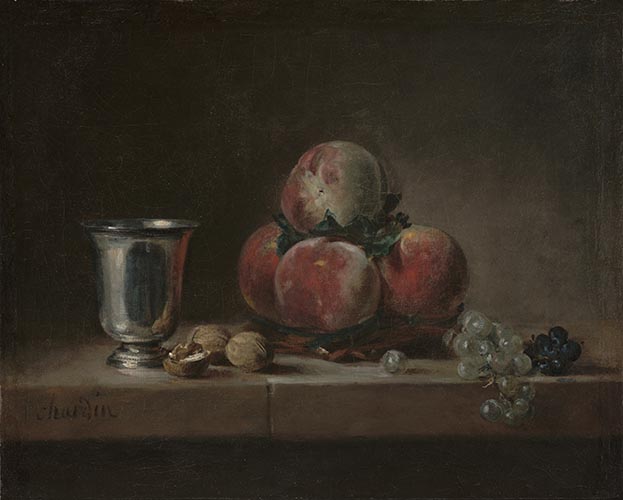Still Life with Peaches, a Silver Goblet, Grapes, and Walnuts
by Jean-Baptiste-Simeon Chardin
In still lifes, genre scenes, and the occasional portrait, Chardin's skill at rendering the visual and tactile qualities of simple objects won him the admiration of critics like Diderot. In this small still life, Chardin portrayed a modest subject--three walnuts, four peaches, two bunches of grapes, and a pewter mug--but gave the objects monumentality by arranging them in pure geometric groupings and concentrating on their basic forms. He suggested the objects' various textures and substances through the play of light across surfaces and successive applications of paint. In this way, Chardin conveyed the fuzzy skin of the peaches, the hard, brittle shell of the walnuts, the translucence of the grapes, and the heavy, cold exterior of the pewter mug.
$550.00
Artwork Details | |||||||
|---|---|---|---|---|---|---|---|
| Date: | 1759 | ||||||
| Medium: | Oil on canvas | ||||||
| Dimensions: | 46cm x 38cm | ||||||
| Genres: | Rococo Realism | ||||||
| Subjects: | Allegory Still Life | ||||||
| More Info: | www.googleartproject.com | ||||||
| |||||||
Reviews to this artwork:
Average Rating: 2.00 of 5.00 stars (2 votes)
You must be logged in to review this artwork. Login here!
Rating: 2/5 stars
But I must explain to you how all this mistaken idea of denouncing pleasure and praising pain was born and I will give you a complete account of the system, and expound the actual teachings of the great explorer of the truth, the master-builder of human happiness.
No one rejects, dislikes, or avoids pleasure itself, because it is pleasure, but because those who do not know how to pursue pleasure rationally encounter consequences that are extremely painful. Nor again is there anyone who loves or pursues or desires to obtain pain of itself, because it is pain, but because occasionally circumstances occur in which toil and pain can procure him some great pleasure.
To take a trivial example, which of us ever undertakes laborious physical exercise, except to obtain some advantage from it? But who has any right to find fault with a man who chooses to enjoy a pleasure that has no annoying consequences, or one who avoids a pain that produces no resultant pleasure? On the other hand, we denounce with righteous indignation and dislike men who are so beguiled and demoralized by the charms of pleasure of the moment, so blinded by desire, that they cannot foresee

